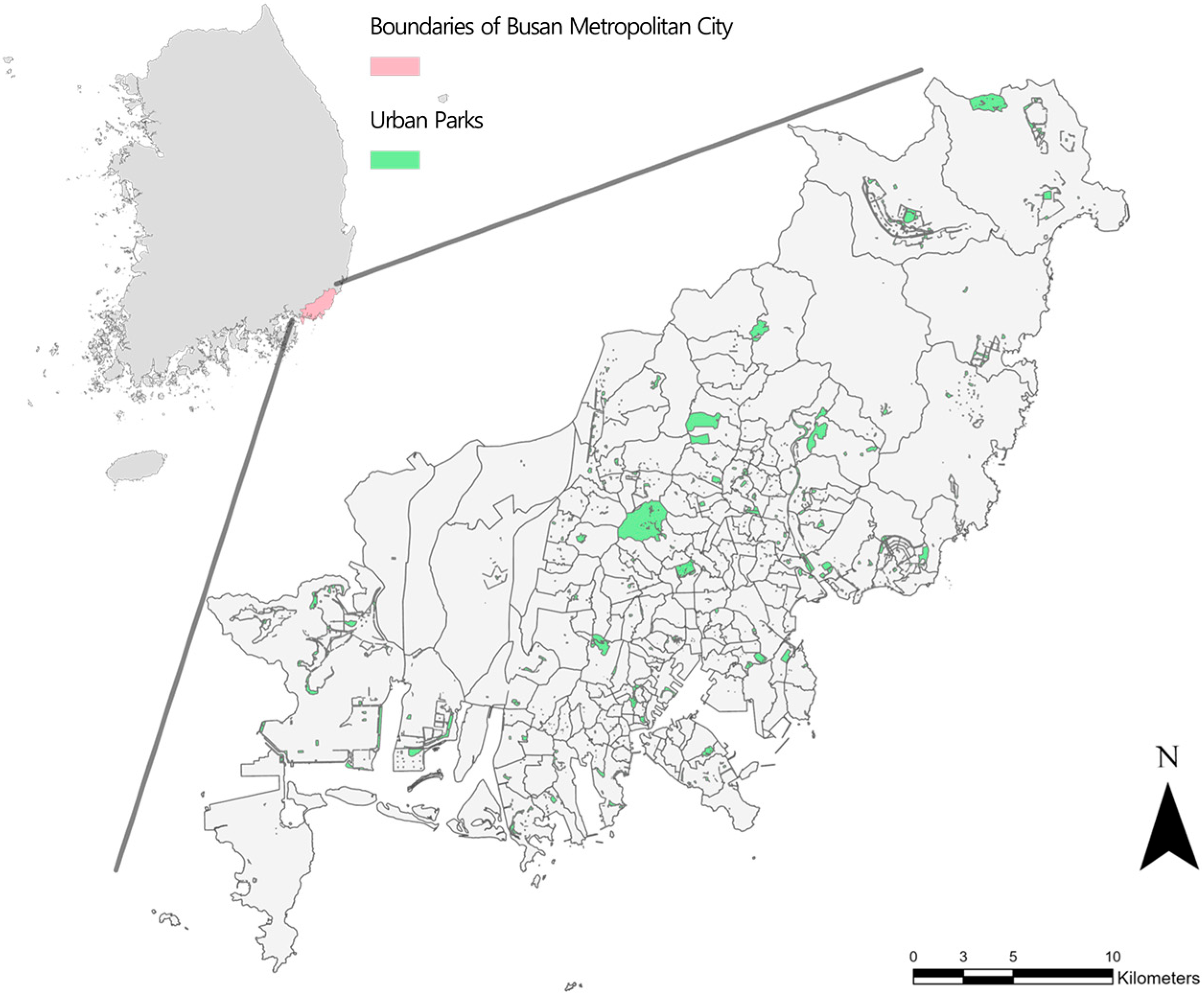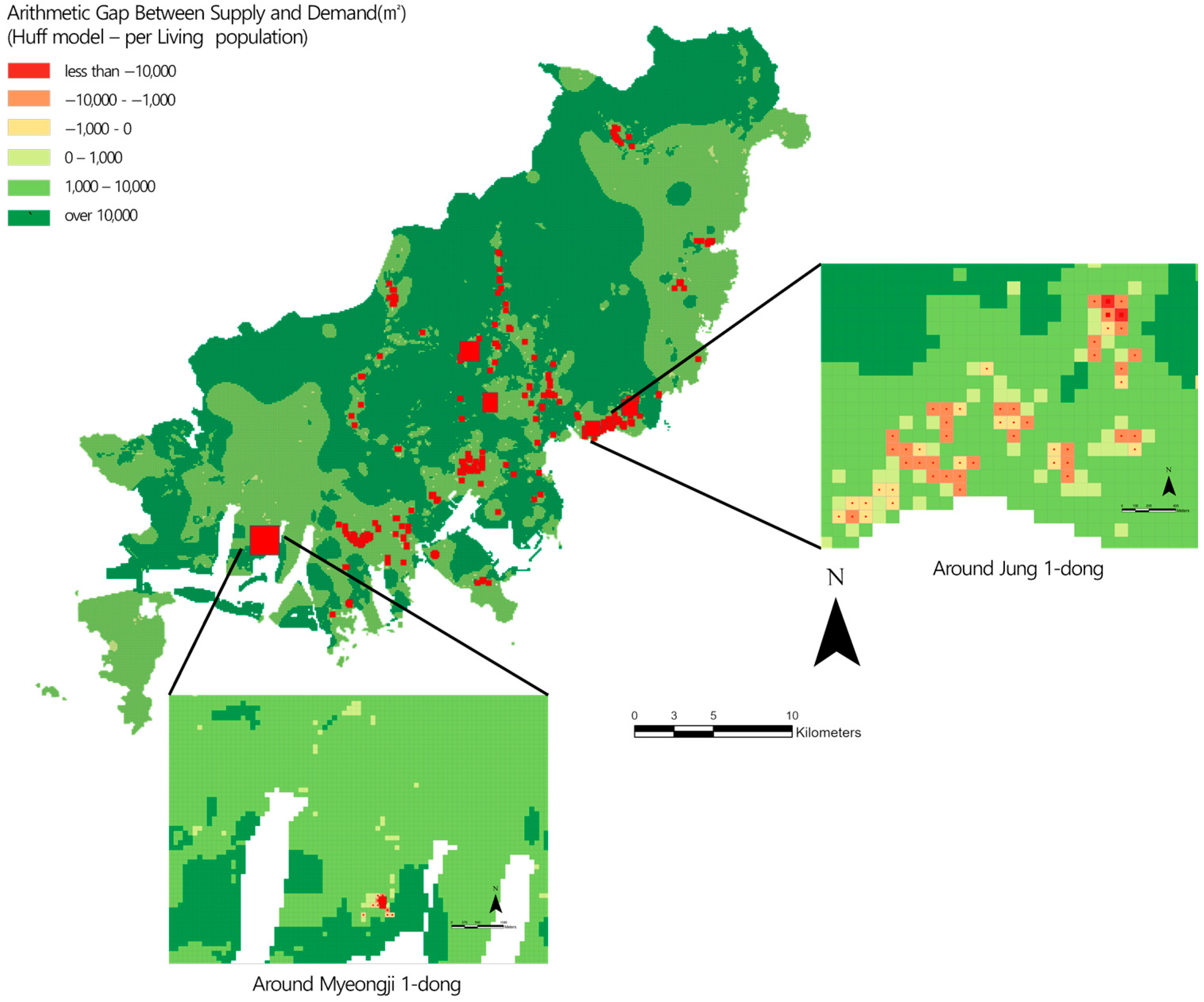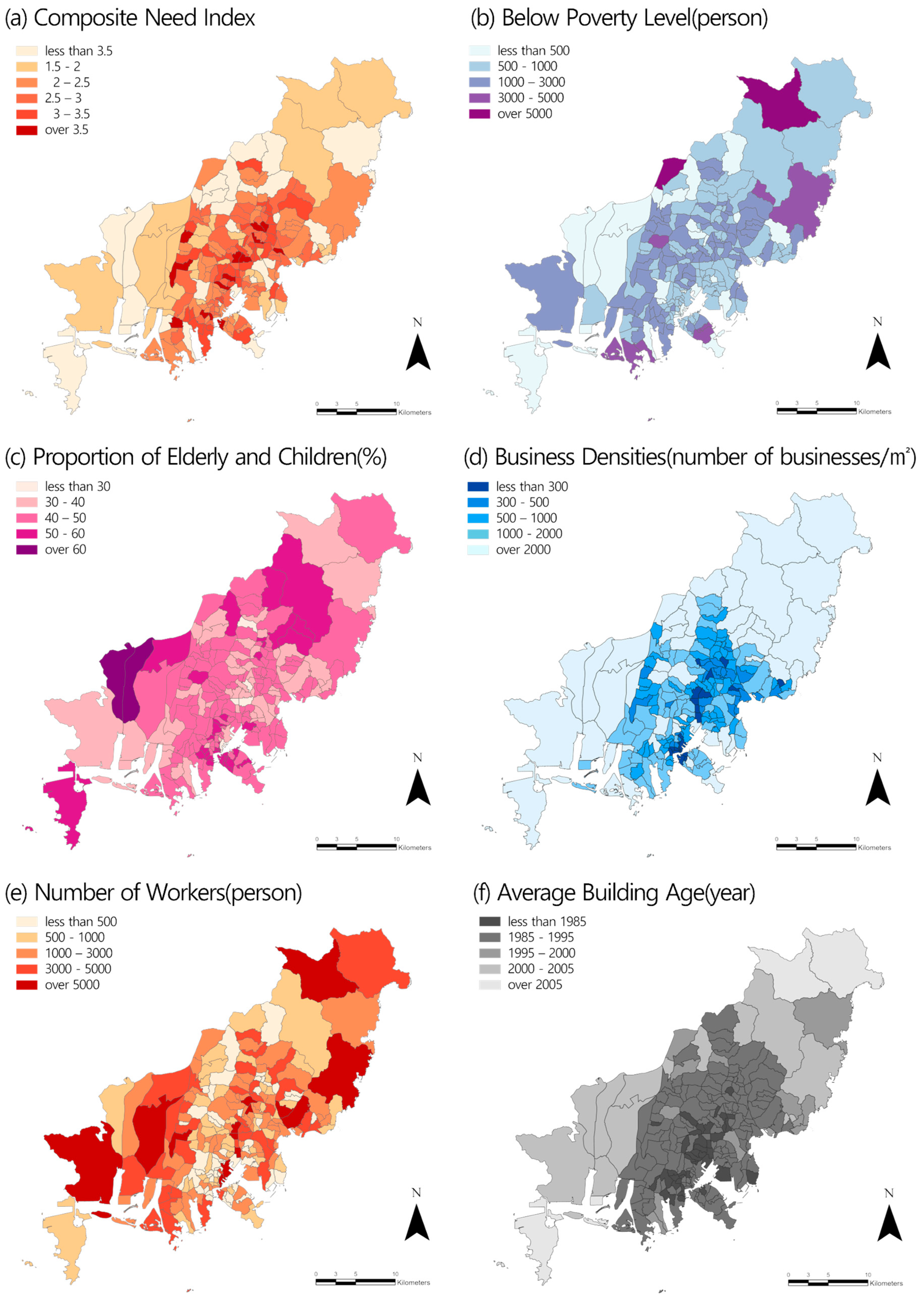Analyzing the Mismatch Between Urban Park Supply and Community Needs in Busan: A Public Health Perspective
Abstract
1. Introduction
2. Materials and Methods
2.1. Contradictory Planning Background in Busan
2.2. Materials
2.3. Methods
2.3.1. Supply Estimation Through Huff Model
2.3.2. Demand Estimation Through Spatial Overlay
3. Results
3.1. Arithmetic Gap Between Supply and Demand: Through Huff Model and Living Population Data
3.2. Spatial Mismatch Between Supply and Demand: Based on Composite Need Index
4. Conclusions and Discussion
4.1. Discussion
4.2. Limitation
4.3. Conclusions
Author Contributions
Funding
Institutional Review Board Statement
Informed Consent Statement
Data Availability Statement
Acknowledgments
Conflicts of Interest
References
- Hobbs, M.; Green, M.A.; Griffiths, C.; Jordan, H.; Saunders, J.; Grimmer, H.; McKenna, J. Access and quality of parks and associations with obesity: A cross-sectional study. SSM Popul. Health 2017, 3, 722–729. [Google Scholar]
- Maas, J.; Van Dillen, S.M.; Verheij, R.A.; Groenewegen, P.P. Social contacts as a possible mechanism behind the relation between green space and health. Health Place 2009, 15, 586–595. [Google Scholar] [CrossRef] [PubMed]
- Sugiyama, T.; Francis, J.; Middleton, N.J.; Owen, N.; Giles-Corti, B. Associations between recreational walking and attractiveness, size, and proximity of neighborhood open spaces. Am. J. Public Health 2010, 100, 1752–1757. [Google Scholar] [CrossRef]
- Sallis, J.F.; Cerin, E.; Conway, T.L.; Adams, M.A.; Frank, L.D.; Pratt, M.; Salvo, D.; Schipperijn, J.; Smith, G.; Cain, K.L.; et al. Physical activity in relation to urban environments in 14 cities worldwide: A cross-sectional study. Lancet 2016, 387, 2207–2217. [Google Scholar]
- James, P.; Banay, R.F.; Hart, J.E.; Laden, F. A review of the health benefits of greenness. Curr. Epidemiol. Rep. 2015, 2, 131–142. [Google Scholar] [CrossRef] [PubMed]
- Sarkar, C. Residential greenness and adiposity: Findings from the UK Biobank. Environ. Int. 2017, 106, 1–10. [Google Scholar] [CrossRef] [PubMed]
- Joye, Y. Architectural lessons from environmental psychology: The case of biophilic architecture. Rev. Gen. Psychol. 2007, 11, 305–328. [Google Scholar]
- Kellert, S.R.; Heerwagen, J.; Mador, M. Biophilic Design: The Theory, Science and Practice of Bringing Buildings to Life; John Wiley & Sons: Hoboken, NJ, USA, 2011. [Google Scholar]
- Chawla, L. Benefits of nature contact for children. J. Plan. Lit. 2015, 30, 433–452. [Google Scholar]
- McCormack, G.R.; Rock, M.; Toohey, A.M.; Hignell, D. Characteristics of urban parks associated with park use and physical activity: A review of qualitative research. Health Place 2010, 16, 712–726. [Google Scholar] [CrossRef]
- Ellaway, A.; Macintyre, S.; Bonnefoy, X. Graffiti, greenery, and obesity in adults: Secondary analysis of European cross sectional survey. BMJ 2005, 331, 611–612. [Google Scholar]
- Park, M.; Lee, J.; Won, J. Navigating Urban Sustainability: Urban Planning and the Predictive Analysis of Busan’s Green Area Dynamics Using the CA-ANN Model. Forests 2024, 15, 1681. [Google Scholar] [CrossRef]
- Rundle, A.; Quinn, J.; Lovasi, G.; Bader, M.D.; Yousefzadeh, P.; Weiss, C.; Neckerman, K. Associations between body mass index and park proximity, size, cleanliness, and recreational facilities. Am. J. Health Promot. 2013, 27, 262–269. [Google Scholar] [CrossRef] [PubMed]
- Wolch, J.R.; Byrne, J.; Newell, J.P. Urban green space, public health, and environmental justice: The challenge of making cities ‘just green enough’. Landsc. Urban Plan. 2014, 125, 234–244. [Google Scholar] [CrossRef]
- Zhang, R.; Zhang, C.Q.; Cheng, W.; Lai, P.C.; Schüz, B. The neighborhood socio-economic inequalities in urban parks in a High-density City: An environmental justice perspective. Landsc. Urban Plan. 2021, 211, 104099. [Google Scholar] [CrossRef]
- Schlosberg, D. Theorising environmental justice: The expanding sphere of a discourse. Environ. Polit. 2013, 22, 37–55. [Google Scholar] [CrossRef]
- Boone, C.G.; Buckley, G.L.; Grove, J.M.; Sister, C. Parks and people: An environmental justice inquiry in Baltimore, Maryland. Ann. Assoc. Am. Geogr. 2009, 99, 767–787. [Google Scholar] [CrossRef]
- Bullard, R.D. Differential vulnerabilities: Environmental and economic inequality and government response to unnatural disasters. Soc. Res. 2008, 75, 753–784. [Google Scholar] [CrossRef]
- Bullard, R.D.; Wright, B. (Eds.) Race, Place, and Environmental Justice After Hurricane Katrina: Struggles to Reclaim, Rebuild, and Revitalize New Orleans and the Gulf Coast; Westview Press: Boulder, CO, USA, 2009. [Google Scholar]
- Mandarano, L.; Meenar, M. Equitable distribution of green stormwater infrastructure: A capacity-based framework for implementation in disadvantaged communities. Local Environ. 2017, 22, 1338–1357. [Google Scholar] [CrossRef]
- Park, M. Persistent Social Vulnerability in Washington DC Communities and Green Infrastructure Clustering. Land 2023, 12, 1868. [Google Scholar] [CrossRef]
- Kim, H.J.; Jung, S.G.; Lee, W.S. Evaluation of supply adequacy of the urban park by spatial imbalance analysis. J. Korean Inst. Landsc. Archit. 2011, 39, 18–27. [Google Scholar] [CrossRef]
- Park, S.H.; Kim, K.S.; Ko, B.O. A Study on the Estimation of Supply and Demand for Children’s Park. Seoul Stud. 2014, 15, 79–93. [Google Scholar]
- Kabisch, N.; Strohbach, M.; Haase, D.; Kronenberg, J. Urban green space availability in European cities. Ecol. Indic. 2016, 70, 586–596. [Google Scholar] [CrossRef]
- Hillsdon, M.; Jones, A.; Coombes, E. Green space access, green space use, physical activity and overweight. Nat. Engl. Comm. Rep. 2011, 67, 30. [Google Scholar]
- Ball, K.; Timperio, A.; Crawford, D. Neighbourhood socio-economic inequalities in food access and affordability. Health Place 2009, 15, 578–585. [Google Scholar] [CrossRef] [PubMed]
- Li, J.; Song, G.; Semakula, H.M.; Dou, Y.; Zhang, S. Food access inequalities in Chinese urban neighborhoods: A case study of the Dalian development zone. Food Secur. 2019, 11, 1087–1099. [Google Scholar] [CrossRef]
- Sturm, R.; An, R. Obesity and economic environments. CA Cancer J. Clin. 2014, 64, 337–350. [Google Scholar] [CrossRef]
- Busan Metropolitan City. 2030 Busan Master Plan For Parks and Greenbelts; Busan Metropolitan City: Busan, Republic of Korea, 2011.
- Chae, J.-H.; Zoh, K.-J.; Kim, S.-J.; Hoh, Y.K.; Hwang, J.-Y. A Study on Operational Systems & Planning Contents of Parks & Green Space Plan—Focused on London, New York, Berlin, Sydney, Seoul. J. Korean Inst. Landsc. Archit. 2014, 42, 91–104. [Google Scholar]
- Lee, J.W. Analysis of Accessibility and Supply Priorities for Urban Parks through Network Analysis; Dong-A University: Busan, Republic of Korea, 2018. [Google Scholar]
- Korea Public Data Portal. Available online: https://www.data.go.kr/ (accessed on 21 April 2025).
- V World from the Ministry of Land, Infrastructure, and Transport. Available online: https://www.vworld.kr/v4po_main.do (accessed on 21 April 2025).
- Korea Statistics Korea. Available online: https://www.kostat.go.kr/ansk/ (accessed on 21 April 2025).
- Haynes, K.E.; Fotheringham, A.S. Gravity and Spatial Interaction Models; WVU Research Repository: Morgantown, WV, USA, 2020. [Google Scholar]
- Huff, D.L. Geographical aspects of consumer behavior. Univ. Wash. Bus. Rev. 1959, 18, 27–37. [Google Scholar]
- Huff, D.L. A probabilistic analysis of shopping center trade areas. Land Econ. 1963, 39, 81–90. [Google Scholar] [CrossRef]
- Lin, T.G.; Xia, J.C.; Robinson, T.P.; Olaru, D.; Smith, B.; Taplin, J.; Cao, B. Enhanced Huff model for estimating Park and Ride (PnR) catchment areas in Perth, WA. J. Transp. Geogr. 2016, 54, 336–348. [Google Scholar] [CrossRef]
- Roksandić, S.; Urošević, D.; Mladenović, N.; Davidović, T.; Carrizosa, E. Huff Location Model of the Bicycle Parking Services. REACT 2011, 2011, 270. [Google Scholar] [CrossRef]
- Wang, S.; Li, M. Green space system design in Luoyang using Huff Model. In Proceedings of the Geoinformatics 2008 and Joint Conference on GIS and Built Environment: The Built Environment and Its Dynamics, Guangzhou, China, 28–29 June 2008; SPIE: Bellingham, WA, USA, 2008; Volume 7144, pp. 1053–1060. [Google Scholar]
- Im, E. Developing a methodological framework for assessing the level of neighborhood park service provision. Korea Spat. Plan. Rev. 2009, 63, 107–122. [Google Scholar]
- Wang, H.; Wei, X.; Ao, W. Assessing Park Accessibility Based on a Dynamic Huff Two-Step Floating Catchment Area Method and Map Service API. ISPRS Int. J. Geo-Inf. 2022, 11, 394. [Google Scholar] [CrossRef]
- Kim, Y.; Byon, Y.J.; Yeo, H. Enhancing healthcare accessibility measurements using GIS: A case study in Seoul, Korea. PLoS ONE 2018, 13, e0193013. [Google Scholar] [CrossRef]
- Rigolon, A.; Flohr, T.L. Access to parks for youth as an environmental justice issue: Access inequalities and possible solutions. Buildings 2014, 4, 69–94. [Google Scholar] [CrossRef]
- Rigolon, A. A complex landscape of inequity in access to urban parks: A literature review. Landsc. Urban Plan. 2016, 153, 160–169. [Google Scholar] [CrossRef]
- Hazlehurst, M.F.; Lanza, H.I.; Rote, W.M.; DeLuca, S.; Anderson, S. Park access and mental health among parents and children during the COVID-19 pandemic. BMC Public Health 2022, 22, 800. [Google Scholar] [CrossRef]
- Cohen, D.A.; Han, B.; Derose, K.P.; Williamson, S.; Marsh, T.; Rudick, J.; McKenzie, T.L. Neighborhood poverty, park use, and park-based physical activity in a Southern California city. Soc. Sci. Med. 2012, 75, 2317–2325. [Google Scholar] [CrossRef]
- Hung, K.; Crompton, J.L. Benefits and constraints associated with the use of an urban park reported by a sample of elderly in Hong Kong. Leis. Stud. 2006, 25, 291–311. [Google Scholar] [CrossRef]
- Drewnowski, A. The economics of food choice behavior: Why poverty and obesity are linked. In Obesity Treatment and Prevention: New Directions; Karger: Basel, Switzerland, 2012; Volume 73, pp. 95–112. [Google Scholar]
- Levine, J.A. Poverty and obesity in the US. Diabetes 2011, 60, 2667–2668. [Google Scholar] [CrossRef]
- Knifton, L.; Inglis, G. Poverty and mental health: Policy, practice and research implications. BJPsych Bull. 2020, 44, 193–196. [Google Scholar] [CrossRef] [PubMed]
- Reuben, A.; James, P.; DeVille, N.V.; Kaufman, J.D.; Ghosh-Dastidar, B.; Mair, C.; Banay, R.F.; Duncan, G.E.; Wang, W.; Boettner, B.; et al. Association of neighborhood parks with child health in the United States. Prev. Med. 2020, 141, 106265. [Google Scholar] [CrossRef] [PubMed]
- Kaczynski, A.T.; Schipperijn, J.; Hipp, J.A.; Besenyi, G.M.; Stanis, S.A.W.; Hughey, S.M.; Wilcox, S. ParkIndex: Development of a standardized metric of park access for research and planning. Prev. Med. 2016, 87, 110–114. [Google Scholar] [CrossRef] [PubMed]
- Kaczynski, A.T.; Hughey, S.M.; Stowe, E.W.; Wende, M.E.; Hipp, J.A.; Oliphant, E.L.; Schipperijn, J. ParkIndex: Validation and application of a pragmatic measure of park access and use. Prev. Med. Rep. 2020, 20, 101218. [Google Scholar] [CrossRef]
- Wang, D.; Brown, G.; Liu, Y.; Mateo-Babiano, I. A comparison of perceived and geographic access to predict urban park use. Cities 2015, 42, 85–96. [Google Scholar] [CrossRef]
- Aronson, M.F.; Clark, J.A.; Hoover, F.A.; Joo, H.E.; Kremer, P.; La Rosa, D.; Larson, K.L.; Lepczyk, C.A.; Lerman, S.B.; Locke, D.H.; et al. Limitations of existing park quality instruments and suggestions for future. Landsc. Urban Plan. 2024, 249, 105127. [Google Scholar]





| Plan | Sustainability and Public Health Goals | Key Targets and Measures | Greenbelt Policy and Contradictions |
|---|---|---|---|
| 2040 Master Plan for BMC |
|
|
|
| 2030 Busan Master Plan for Parks and Greenbelts |
|
|
|
| Communities (District) | Number of Grids with Park Need | Required Park Area (m2) | Characteristics |
|---|---|---|---|
| ①Mora 1-dong (Sasang-gu) | 2 | 2367.41 | Mora 1-dong is within Sasang-gu, and the district is located in the western part of Busan. Due to the formation of the Sasang Industrial Complex, manufacturing and logistics industries have developed, and it is mainly responsible for industrial functions. Recently, residential and commercial functions have been expanding. |
| ②Goejeong 1-dong (Saha-gu) | 23 | 16,322.34 | Goejeong 1-dong is located in Saha-gu, in the southwestern part of Busan. It is a hub for the shipbuilding and fishing industries in Busan. |
| ③Ami-dong (Seo-gu) | 3 | 328.47 | Ami-dong is located in Seo-gu, one of the downtown areas of Busan, and is close to Busan Port, so the shipping and logistics industries are developed. In addition, medical facilities such as Busan National University Hospital are concentrated, so the medical industry also plays an important role. |
| ④Namhang-dong (Yeongdo-gu) | 5 | 2769.84 | Yeongdo-gu is an island area located east of Busan Port, and is the old center of the shipbuilding industry and has developed marine-related industries. |
| ⑤Beomil 2-dong (Dong-gu) | 17 | 17,714.17 | Beomil 2-dong is located in Dong-gu. Dong-gu is located in the central region of Busan and serves as a transportation hub where Busan Station is located, and it is an area where commerce and shipping are developed. |
| ⑥Bujeon 1-dong (Busanjin-gu) | 1 | 254.01 | This community is within Busanjin-gu. This district is located in the center of Busan, and is the largest commercial and business district in Busan centered around Seomyeon. Large department stores and financial institutions are concentrated, with residential and business areas mixed together. |
| ⑦Yeonsan 2-dong (Yeonje-gu) | 6 | 35,021.04 | Yeonsan 2-dong is situated in Yeonje-gu and serves as the administrative center of Busan, housing the Busan Metropolitan City Hall. The area is densely populated with public institutions and legal districts. It is also a well-developed residential area. |
| ⑧Sumin-dong (Dongnae-gu) | 1 | 914.9 | Sumin-dong is an administrative district in Dongrae-gu, which is situated in the central part of Busan. The area serves as a historical and cultural hub |
| ⑨Mangmi 1-dong (Suyeong-gu) | 2 | 642.49 | Both communities are located in Suyeong-gu, which is located in the southern part of Busan and is the smallest district by area. It is a hub for marine tourism, centered around Gwangalli Beach and the Suyeong River. The district features a mix of residential and commercial areas. |
| ⑩Suyeong-dong (Suyeong-gu) | 2 | 913.75 |
Disclaimer/Publisher’s Note: The statements, opinions and data contained in all publications are solely those of the individual author(s) and contributor(s) and not of MDPI and/or the editor(s). MDPI and/or the editor(s) disclaim responsibility for any injury to people or property resulting from any ideas, methods, instructions or products referred to in the content. |
© 2025 by the authors. Licensee MDPI, Basel, Switzerland. This article is an open access article distributed under the terms and conditions of the Creative Commons Attribution (CC BY) license (https://creativecommons.org/licenses/by/4.0/).
Share and Cite
Park, D.; Lee, J.; Park, S.; Park, M. Analyzing the Mismatch Between Urban Park Supply and Community Needs in Busan: A Public Health Perspective. Sustainability 2025, 17, 4049. https://doi.org/10.3390/su17094049
Park D, Lee J, Park S, Park M. Analyzing the Mismatch Between Urban Park Supply and Community Needs in Busan: A Public Health Perspective. Sustainability. 2025; 17(9):4049. https://doi.org/10.3390/su17094049
Chicago/Turabian StylePark, Doyoung, Jaekyung Lee, Seongbeom Park, and Minkyu Park. 2025. "Analyzing the Mismatch Between Urban Park Supply and Community Needs in Busan: A Public Health Perspective" Sustainability 17, no. 9: 4049. https://doi.org/10.3390/su17094049
APA StylePark, D., Lee, J., Park, S., & Park, M. (2025). Analyzing the Mismatch Between Urban Park Supply and Community Needs in Busan: A Public Health Perspective. Sustainability, 17(9), 4049. https://doi.org/10.3390/su17094049






